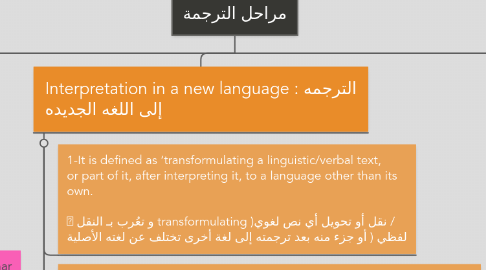
1. Editing the source text
1.1. تحرير النص المصدر
1.1.1. 1. Editing the ST is the study of the ST for establishing its authorship and authenticity and for reaching a linguistic form which is accepted for translation
1.1.2. 1- تحرير النص المصدر ST أي دراسته و الغرض منها هو ترسيخ أصالتة و موثوقيتّة وأيضاً لغرض الوصول إلى نموذج لغويّ مقبول عند الترجمة.
1.2. 2. Editing a ST is important in case of inscriptions on metal, stones clay tablets or other materials found on archaeological sites
1.2.1. 2- تحرير النص المصدر يعد مهماً جداً في حالة العثور على معادن منقوشة , كأقراص الأحجار الطينيه أو المواد الأخرى التي تتواجد في مواقع الآثار .
1.2.2. 3. The translator may not be involved in this stage whether the ST is old or new.
1.2.2.1. 3- قد لا يكون المترجم معنيِاً في هذه المرحلة سواء كان النص المصدر قديم أم حديث .
1.3. 4-4. The Editing of a ST precedes it s translation.
1.3.1. 4. . عمليه تحرير النص المصدر تسبق عملية الترجمه -
1.4. 5. When editing or transcribing a text recorded on a cassette or a videotape, a number of factors should be considered as clarity of the recording, or the image on a video tape and knowledge of the dialects or slangs used in the ST. In such case the translator translates what is heard from a machine directly and commits it to writing it on paper or a screen.
1.4.1. 5- أو الصور التي تظهر في شريط الفيديو والمعرفه باللهجات المختلفة و منها العامّية المستخدمه في النص المصدر , وفي هذه الحاله فالمترجم يترجم ما يسمعه عند تحرير أو كتابة نص ُمُسجل في كاسيت أو شريط فيديو ,هناك عده عوامل يجب أخذها بعين الإعتبار منها وضوح التسجيل مباشرةً من الآله ويلتزم بكتابته على الورقة أو الشاشة.
1.5. 6. When the ST has been edited and adopted for translation, the translator then moves to another stage which is the stage of interpretation of the Source Text.
1.5.1. 6- حينما يفُرَغ من تحرير النص المصدر وُيُعتمد لبدء الترجمه , ينتقل المترجم حينها لمرحله أخرى وهي مرحلة ترجمه النص المصدر .
2. Interpretation of the source text
2.1. ترجمه النص المصدر
2.1.1. 1-Interpretation within the same language is seen as
2.1.2. تعتبر الترجمه من اللغه و إليها
2.2. 2-Giving the ST a reading which goes with lexis, grammar and meaning of the text in its linguistic and social context.
2.2.1. أعطاء النص المصدر قراءه تتماشى مع المفردات و القواعد ومعنى النص في محتواه اللغوي و الإجتماعي .
2.2.2. 3-The process of assigning meaning to the text or utterances in it depends on the linguistic systems and contexts of the source Language. 3-
2.2.2.1. . عملية إسناد معنى النص و نطقة تعتمد على النظام اللغوي و سياق اللغة المصدر .
2.3. 4-The interpretation of a ST for giving it a specific meaning is a constructive process which involve s: a linguistic analysis of the written/spoken symbols, script, sounds, lexico-grammatical relations within the sentences and .
2.3.1. 4. ترجمة النص المصدر بغرض إعطاءه معنىً خاص هي عملية بنائيه تتضمن : التحليل اللغوي للرموز المكتوبة و المنطوقة ,المخطوطات , الأصوات , العلاقة النحوية بالمفردات ما بين الجمل.
2.4. 5-This newly built message will find its way to another language in terms of interpretation in a new language and formulation. This newly built message will find its way to another language in terms of interpretation in a new language and formulation.
2.4.1. . هذه الرساله المبنيه حديثاً ستجد طريقها في اللغه الجديده من حيث ترجمتها و صياغتها إليها .
2.5. 6-The translator’s reading, judgement and decision concerning the meaning of a source text tend to be subjective and individualistic.The translator’s reading, judgement and decision concerning the meaning of a source text tend to be subjective and individualistic.
2.5.1. قراءة وحكم وقرار المترجم حول معنى النص الاساسي ) المصدر( يميل الى ان يكون ذاتي اً وفردي اً
2.6. 7 The translator however should take into account all other interpretations given to the ST to be translated especially in religious texts, old literary texts.
2.6.1. 7)و المترجم عليه أن يأخُذ في الحسبان جميع التراجم و التفاسير المتاحه للنص المصدر عند ترجمتها و خصوصا النصوص الدينيه و الادبيه العتيقة .
3. Interpretation in a new language : الترجمه إلى اللغه الجديده
3.1. 1-It is defined as ‘transformulating a linguistic/verbal text, or part of it, after interpreting it, to a language other than its own. و تعُرب بـ النقل transformulating )نقل أو تحويل أي نص لغوي / لفظي ( أو جزء منه بعد ترجمته إلى لغة أخرى تختلف عن لغته الأصلية
3.2. 2-This transformulation is carried out by the translator and carries his/her fingerprints and uniqueness since it shows his/her interpretation of the source text, and the results from his /her interpretation in a new language. هذا التحول يقوم بتنفيذه المترجم وهو يحمل إبداعة و بصماته حيث أنه يعرض ترجمته الشخصيه للنص ونتاج عمله في نقلة إلى اللغة الجديده .
3.3. 3-The end product, interpretation in a new language, is a new text, the translated text. والناتج الأخير لدينا هو ترجمه للغُة الجديده , نص جديد و مُترجم .
3.3.1. 4-The most important aspect of interpretation in a new language is the movement –the crossing- from one language to another. من أهم عناصر الترجمه إلى اللغة الجديده هي عملية -العبورthe crossing - من لغة لأخُرى .

